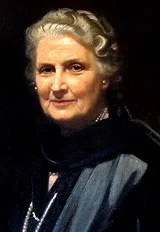The Montessori Method
Dr. Maria Montessori opened the Casa dei Bambini, or “Children’s House,” in Rome in January of 1907. Through her observation of the children themselves, Dr. Montessori developed an innovative, child-centered approach to education.
She observed that children have a spontaneous desire to learn from and interact with their environment, essentially teaching themselves. To this end, she set about to create a setting designed to enable that process.
She believed that when the child began to concentrate upon the task, it was no longer necessary to interrupt or even encourage the child. She said, “Praise, help, or even a look may be enough to interrupt him, or destroy the activity. The great principle which brings success to the teacher is this: as soon as concentration has begun, act as if the child does not exist.”
The Montessori classroom is filled with activities and practical life exercises which children can select and work on for themselves. Teachers guide children and help them before and after the period in which the child is essentially teaching himself or herself.
There are now over a hundred years of evidence that the Montessori Method provides children with the environment to foster their own natural desire to learn, grow, and thrive — and that the Montessori environment produces excellent results including concentration, love of learning, independence, confidence, and spontaneous self-discipline.
To learn more about the Montessori Method and the life of Dr. Montessori, please visit the website of the American Montessori Society, or contact us to talk and schedule a visit to Discovery Children’s House!
It is not true that I invented what is called “the Montessori Method.” I have studied the child. I have taken what the child has given me and expressed it, and that is what is called the Montessori Method.
Dr. Maria Montessori
